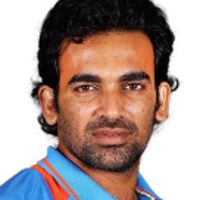England keep hopes alive chasing 500
With India having desisted from enforcing the follow-on, England began their second innings in much better fashion than their first, stitching together 56 for no loss in pursuit of an unlikely 500 for victory
The Bulletin by Anand Vasu
12-Aug-2007
England 345 and 56 for 0 need 444 to beat India 664 and 180 for 6 dec (Ganguly 57)
Scorecard and ball-by-ball details
How they were out
Scorecard and ball-by-ball details
How they were out
|
|

|
If the first three days had mostly followed India's script, the fourth saw England throw some clunkers into it. At the end of the day, India, however, were still very much on top, with England on 56 for no loss in their second dig, chasing a highly improbable 500 for victory, looking to play out 90 overs on the final day to hang on for the draw. What's more, England have never batted out 110 overs in the final innings at The Oval.
When the day began, the focal point was the follow-on, and whether India would enforce it, and go for the kill. They didn't enforce the follow-on, but if you ask Rahul Dravid, he will tell you he was doing what he thought would give India the best chance of sealing a series win. And that's a logic you can hardly fault, even if the execution went horribly wrong for a time.
First Chris Tremlett and Monty Panesar stuck around more than seven overs, extending the England innings, and pushed the score to 345 before Panesar was trapped in front by Anil Kumble. The delay meant that what little temptation there was to stick England back in - if at all there was one in the first place - had evaporated. Then, as Dravid walked off, with a lead of 319, he signalled for the light roller to be used on the wicket, indicating that India would not be enforcing the follow-on, and giving a broader insight into how he planned to play out this game.
Then, when India batted, presumably with the hope of batting long enough to put the game completely out of England's reach, came the most absorbing passage of play. The clouds rolled in, as if to mock India's decision not to enforce the follow-on, and James Anderson, Paul Collingwood, and even Chris Tremlett coaxed swing out of the new Duke ball. India would have been more than happy that Ryan Sidebottom, England's No. 1 swing bowler, was out of action with a side strain.
However, India could have hardly begun worse if Sidebottom, or anyone else for that matter, was around. In the space of 11 runs they had lost three wickets, and Dravid's plan seemed to be backfiring spectacularly. Wasim Jaffer's habit of shouldering arms in almost predetermined fashion cost him dear. Few umpires have sympathy for batsmen who don't play with the bat, but Ian Howell just doesn't seem to have any sympathy for anyone at the moment, period. Though Jaffer had left the ball on length, and it appeared to be clearing the stumps with some ease, Howell thought long and hard, through a wonderfully sustained and optimistic appeal, and gave the batsman out.
Dinesh Karthik was late on a ball from Tremlett that bounced a touch more than he expected and edged straight to Paul Collingwood at slip. The Sunday crowd then gave Sachin Tendulkar, who they might have bid farewell to a couple of days ago, yet another warm welcome as he came out to bat for what should be the last time in Tests in England. One run later they were equally polite in applause as Tendulkar made his way back to the pavilion after James Anderson swung one ball enough to beat the middle of the bat in an attempted cover drive and make a mess of the stumps via the inside edge.
At 11 for 3, Dravid was sweating, even though the lead meant that India were in effect 330 for 3. Dravid's batting had become dour and defensive to the point that the crowd was ironically cheering each single, and there weren't too many, as Dravid took 63 balls to get to five. In the middle of this playing and missing, and failing to put away bad deliveries, with India looking like they might have succumbed to their own negative mindset, Sourav Ganguly shone through.
|
|

|
All series Ganguly has looked as assured and determined at the crease as he has in any time in his career, and on the day he wound the clock back a decade and a bit to recapture the pristine timing and placement that he announced himself to the world stage with in England in 1996. He pinged the ball into the gaps in the off side when it was just a touch loose, evading multiple gullies and finding the third-man boundary repeatedly. He cover-drove with the laziest elegance, and grew so confident that he was even working the ball through his weaker leg side with aplomb. When Ganguly got to his 50, off only 53 balls, the fastest of the nine half-centuries to come in the game, India had just 69 on the board. But it was too good to last, and on 57 he edged Collingwood, who was getting the ball to swing dangerously late, to Strauss.
Dravid, who had almost doubled his score with one blow, square-cutting the 91st ball he faced, from Panesar for a boundary, fell soon after, edging to slip. Dravid's 96-ball 12 left India at 89 for 5, an overall lead of 408. The scoreboard showed India were well on top, but you would not have known that watching India bat. England had their tails up and India were forced to consolidate.
But, India's captain had obviously worked out what he wanted to do, and the hassle was merely in the execution. That was set right by VVS Laxman and Mahendra Singh Dhoni, who put together 69, and allowed India to get to 180 before they could declare leaving England exactly 500 to make, off a minimum of 110 overs over a day and half a session.
Alastair Cook (27 not out) and Andrew Strauss (23 not out) ensured that the tricky 20-over passage of play in the dying light of the fourth day was safely negotiated, and England closed on 56 for no loss. They still need 444 from 90 overs on the final day to pull off a miracle win; India needed 10 wickets for a 2-0 series win, and mere containment to take the series 1-0. They'd prefer the first, but after 21 years of waiting to win a series in England, would happily settle for the second.
Anand Vasu is associate editor of Cricinfo



